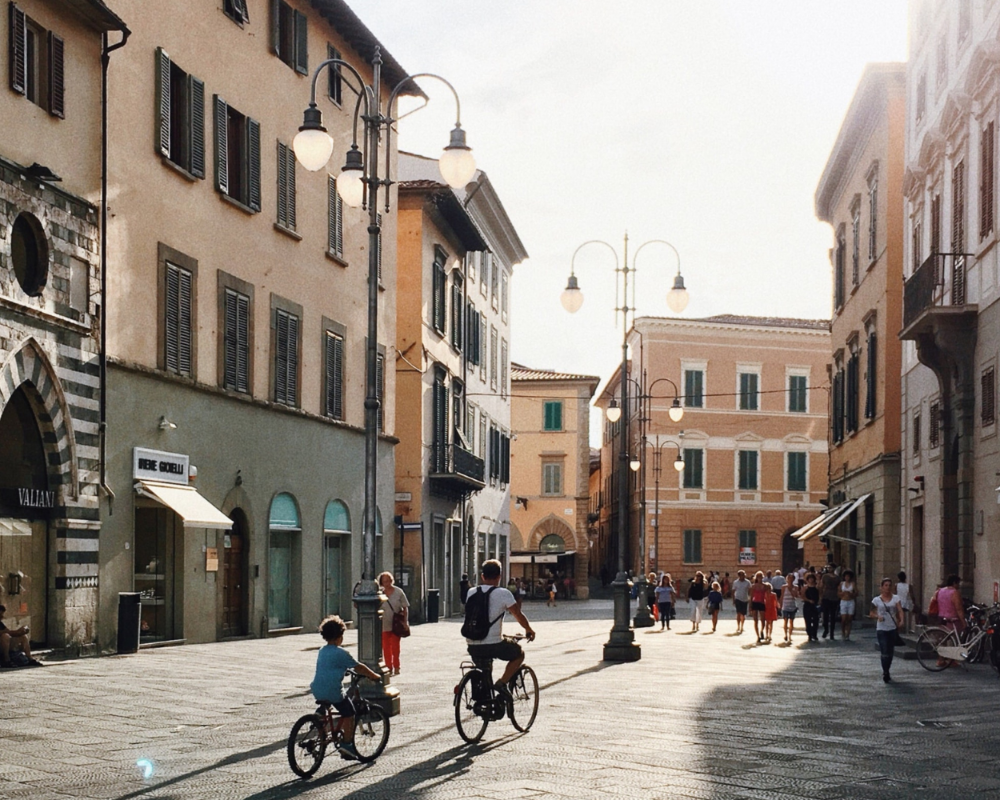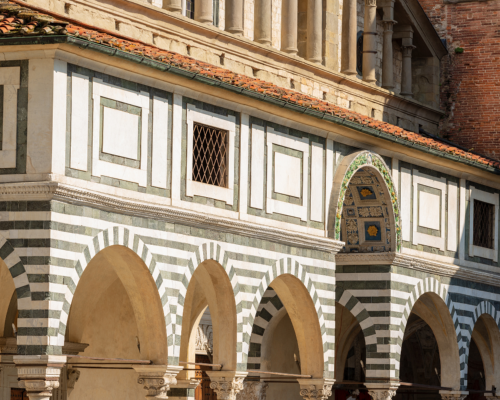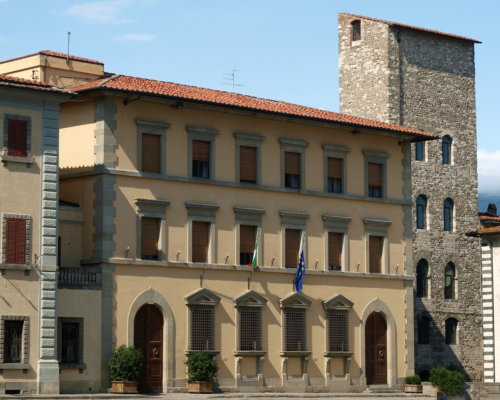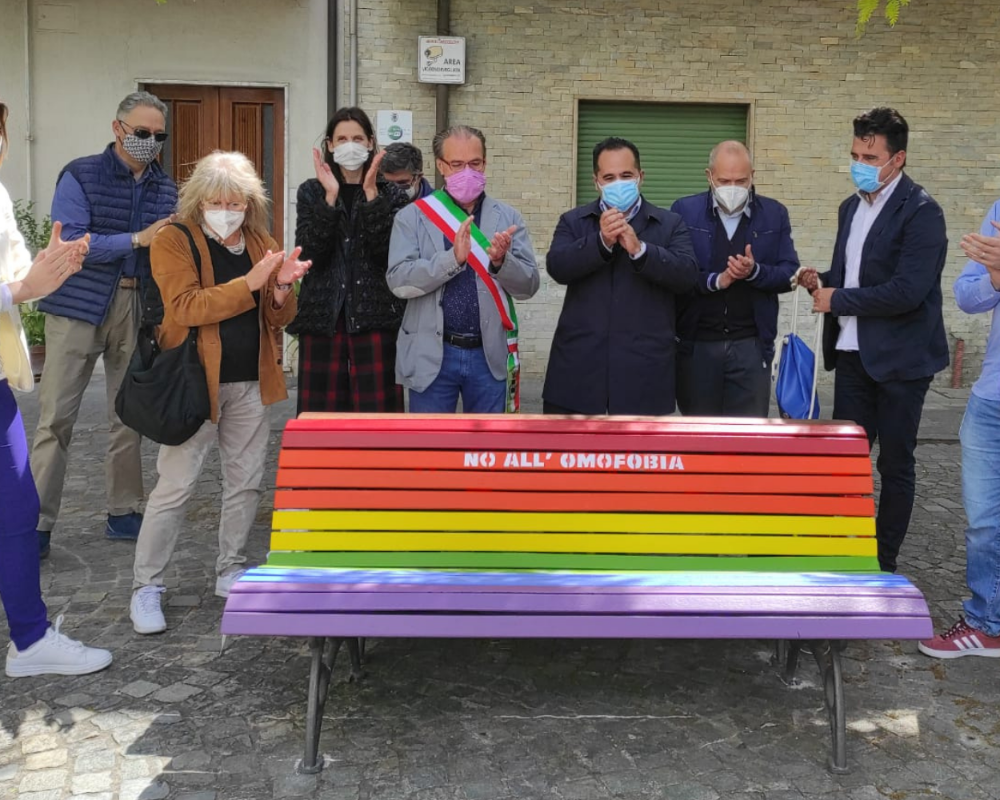


A walk through the city's rainbow places
Pistoia never ceases to amaze. It's perfect for lovers of both art and traditional Tuscan cuisine. The city has a lot to offer: you can reach the main tourist attractions from the main piazza, and by casting an eye around you'll see there's even more to be revealed.
In this article, we recommend a walk through the center of Pistoia that will allow you to discover the places and history of some important historical figures. We will talk about Renaissance artists and street art, one of the best known Roman senators and a monument that we should all visit.
This itinerary is perfect for both walking and cycling.
We begin our walk from the San Zeno Cathedral, a Romanesque church that dates to before 1000. The interior of the cathedral is divided into three naves with magnificent frescoes decorating the vaults and walls.
Heading towards the Chapel of the Crucifix, we can admire a masterpiece of medieval Italian jewelery: the altar of San Jacopo, in embossed silver foil. The work was created by various artists, including a young Filippo Brunelleschi who, according to some critics, sculpted the two busts of the prophets Jeremiah and Isaiah, a full-length Saint Augustine and a seated Saint John the Evangelist.
Brunelleschi was one of the geniuses of the Tuscan Renaissance and like many artists of his time, he was accused of having a dissolute life. He was a great friend of Donatello, and some say he was also his lover. Just like Donatello, Brunelleschi never married, and left all his belongings to his adopted son Buggiano.
Whether or not this is true, the story can be a starting point for learning about some LGBTQ+ Renaissance love stories.
We begin our walk from the San Zeno Cathedral, a Romanesque church that dates to before 1000. The interior of the cathedral is divided into three naves with magnificent frescoes decorating the vaults and walls.
Heading towards the Chapel of the Crucifix, we can admire a masterpiece of medieval Italian jewelery: the altar of San Jacopo, in embossed silver foil. The work was created by various artists, including a young Filippo Brunelleschi who, according to some critics, sculpted the two busts of the prophets Jeremiah and Isaiah, a full-length Saint Augustine and a seated Saint John the Evangelist.
Brunelleschi was one of the geniuses of the Tuscan Renaissance and like many artists of his time, he was accused of having a dissolute life. He was a great friend of Donatello, and some say he was also his lover. Just like Donatello, Brunelleschi never married, and left all his belongings to his adopted son Buggiano.
Whether or not this is true, the story can be a starting point for learning about some LGBTQ+ Renaissance love stories.
We continue our walk to reach the Tower of Catilina, one of the city's symbolic sites. The tower is located in via della Tomba di Catilina 2, and is a ninth century building made entirely of stone that's about 30 meters high.
Catiline was a Roman politician, soldier and senator born in 108 BC who made history for the conspiracy that intended to overthrow the Roman Republic. The conspiracy was thwarted and Catiline was killed by the republican army led by Marco Petreio on January 5, 62 BC. The tower owes its name to the fact that Lucio Sergio Catilina is said to have been buried there.
Catiline is a very interesting figure in Roman history, he was highly ambitious and attacked for his way of dress. He is one of those people who was accused of being "too effeminate" in those times. Catilina, together with Gaius Julius Caesar, Marco Antonio and Publio Clodio Pulcro were publicly mocked because they were always well dressed and perfumed.
“People of his taste, or to put it better, who are close and loved by him! Look at them! With smoothed hair, shiny with oil, shaved or with an artistic beard, in long-sleeved tunics, not girded with togas, but only with veils. Only active and tireless when it comes to feasting all night! In this pack, you'll find the cheaters, the adulterers, the seducers, the corrupt and the shameless of Rome."
Cicerone
At that time, there were also rumours about adventures with other men. It's no coincidence that the year of Catiline's death is also the year of the most famous scandal in Ancient Rome, when Clodio Pulcro disguised himself as a flautist to participate in the rites of the Bona Dea which were exclusively for women. To date, this is the first known and witnessed case of cross-dressing in history.
We continue our walk to reach the Tower of Catilina, one of the city's symbolic sites. The tower is located in via della Tomba di Catilina 2, and is a ninth century building made entirely of stone that's about 30 meters high.
Catiline was a Roman politician, soldier and senator born in 108 BC who made history for the conspiracy that intended to overthrow the Roman Republic. The conspiracy was thwarted and Catiline was killed by the republican army led by Marco Petreio on January 5, 62 BC. The tower owes its name to the fact that Lucio Sergio Catilina is said to have been buried there.
Catiline is a very interesting figure in Roman history, he was highly ambitious and attacked for his way of dress. He is one of those people who was accused of being "too effeminate" in those times. Catilina, together with Gaius Julius Caesar, Marco Antonio and Publio Clodio Pulcro were publicly mocked because they were always well dressed and perfumed.
“People of his taste, or to put it better, who are close and loved by him! Look at them! With smoothed hair, shiny with oil, shaved or with an artistic beard, in long-sleeved tunics, not girded with togas, but only with veils. Only active and tireless when it comes to feasting all night! In this pack, you'll find the cheaters, the adulterers, the seducers, the corrupt and the shameless of Rome."
Cicerone
At that time, there were also rumours about adventures with other men. It's no coincidence that the year of Catiline's death is also the year of the most famous scandal in Ancient Rome, when Clodio Pulcro disguised himself as a flautist to participate in the rites of the Bona Dea which were exclusively for women. To date, this is the first known and witnessed case of cross-dressing in history.
Strolling through the streets of the centre to reach the next stop, you will come across street art works of all sizes. In addition to the famous mural by Miilo titled “No Hesitation” located in the Giardino di Cino, there are works by other well-known street art artists, including Blub.
Blub's works are fun and recognizable: all the subjects wear a diving mask and seem to pose at the bottom of the sea. Some of his works can be found in via degli Orafi and in via della Nave, and the subjects portrayed range from Dalì and Bia de Medici to pop icons of LGBTQ+ culture such as Marilyn Monroe.
Strolling through the streets of the centre to reach the next stop, you will come across street art works of all sizes. In addition to the famous mural by Miilo titled “No Hesitation” located in the Giardino di Cino, there are works by other well-known street art artists, including Blub.
Blub's works are fun and recognizable: all the subjects wear a diving mask and seem to pose at the bottom of the sea. Some of his works can be found in via degli Orafi and in via della Nave, and the subjects portrayed range from Dalì and Bia de Medici to pop icons of LGBTQ+ culture such as Marilyn Monroe.
Taking the streets from the historic center, we walk towards Piazza San Francesco. Before reaching the square, it might be a good idea to visit one of the many museums that populate the city to find out more about the art and history of Pistoia.
Once you arrive in Piazza San Francesco, you will find the first monument in Tuscany created in memory of the homosexual victims during Nazi exterminations.
The monument was built in 2015, with the collaboration of the Arcigay Pistoia La Fenice association, now known as the Arcigay Prato Pistoia l'Asterisco. It's one of the symbolic places to discover the LGBTQ+ movement in Tuscany.
Taking the streets from the historic center, we walk towards Piazza San Francesco. Before reaching the square, it might be a good idea to visit one of the many museums that populate the city to find out more about the art and history of Pistoia.
Once you arrive in Piazza San Francesco, you will find the first monument in Tuscany created in memory of the homosexual victims during Nazi exterminations.
The monument was built in 2015, with the collaboration of the Arcigay Pistoia La Fenice association, now known as the Arcigay Prato Pistoia l'Asterisco. It's one of the symbolic places to discover the LGBTQ+ movement in Tuscany.

If you are following your own itinerary by bicycle or if you have a car at your disposal, you could continue the itinerary by exploring the surroundings of Pistoia.
Stop outside Pistoia in the nearby town of Quarrata where a rainbow bench was inaugurated on the occasion of the World Day Against Homotransbiphobia 2021. It's a symbol of rejection against all discrimination and all violence against people due to their sexual orientation or their gender identity. The rainbow bench is located in Piazza Risorgimento.